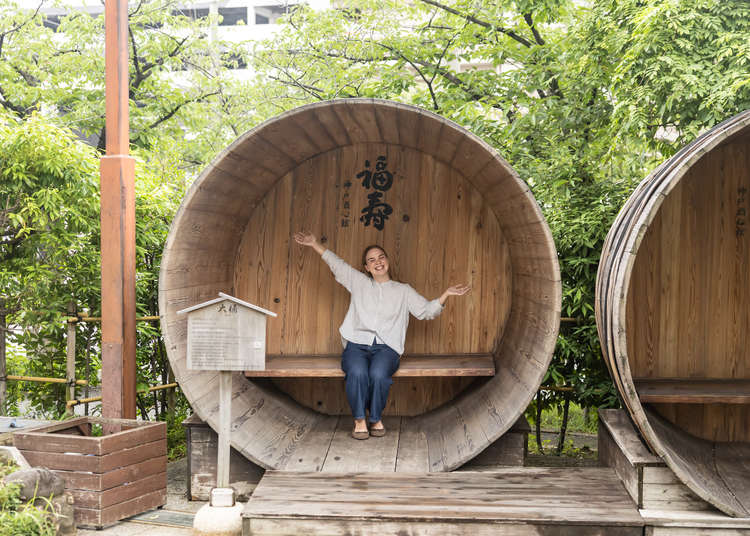
History and Sustainable Brewing: World-Renowned Fukuju Sake at Kobe Shushinkan
- Written by: WESTPLAN
Along the coastline from Kobe City to Nishinomiya in Hyogo Prefecture lies Nada-Gogo, one of Japan’s largest sake-producing regions. Divided into five villages, it is home to lots of sake breweries, each producing their own unique types.
Today we join local resident and long-time sake journalist Kiko Matsuda as she takes sake-beginner Johanna around, introducing her to sake culture and how to enjoy it. The destination of choice: Kobe Shushinkan.
This page contains promotional content.
- Table of Contents
-
- All About Kobe Shushinkan: Home of the World’s Favorite Fukuju Sake
- Book A Tour and Experience the Wonders of Kobe Shushinkan
- Fukuju’s Goal: Sustainable Brewing for the Future
- Sake Tasting: Find Your Favorite Fukuju Flavor
- Pairing Sake and Cuisine, Brewery Style
- Take Home a Memory! Kobe Shushinkan’s Souvenir Selection
- Discovering the Deeper Appeal of Sake at Kobe Shushinkan
- Picking the Perfect Pass for Your Nada-Gogo Visit
All About Kobe Shushinkan: Home of the World’s Favorite Fukuju Sake
270+ Years of History and Global Recognition
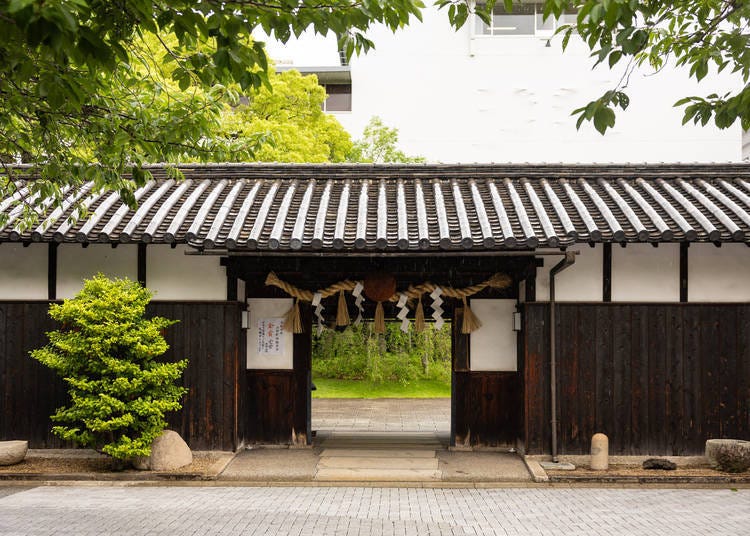
Kobe Shushinkan is a sake brewery in Mikage-go, one of the five villages of Nada-Gogo. Founded in 1751, it is known for Fukuju, a sake brand crafted through traditional brewing techniques.
Fukuju has earned global recognition, having even been served at the Nobel Prize Banquet. Other recent accolades include the Gold Award at the International Wine Challenge 2025, and the Gold Award at Kura Master 2025, a competition judged by some of France’s top sommeliers. It even won the Gold Prize at Japan’s own 2025 National New Sake Awards (brewed in 2024), marking its third consecutive win amongst 21 total. Truly an incredible record of achievement!
A Tourist-Friendly Destination with Multilingual Support
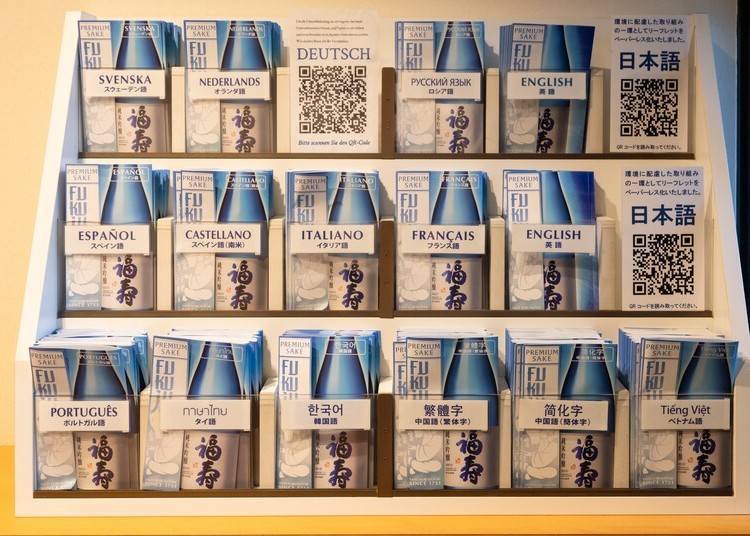
The brewery’s pamphlets are available in 16 languages, with price cards written in four. It is also staffed by knowledgeable international employees, some of who can even speak English, Italian, Spanish, Chinese, and Portuguese. Thanks to these services, it has become quite a popular destination for visitors from overseas.
Book A Tour and Experience the Wonders of Kobe Shushinkan
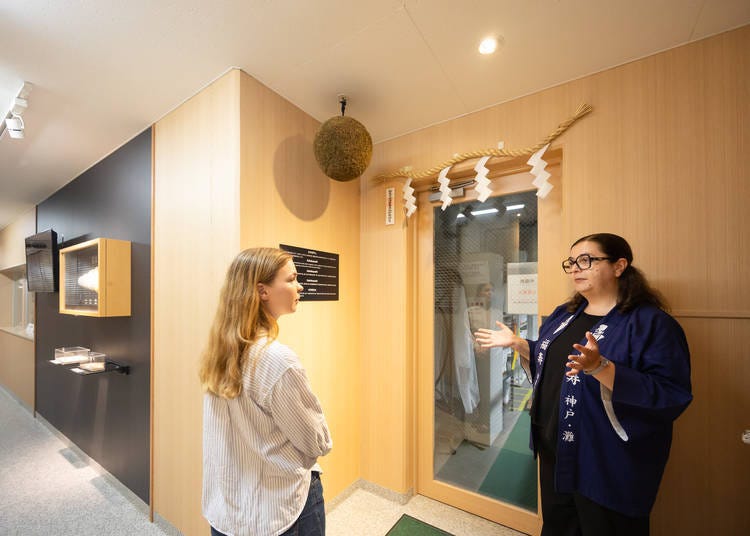
Kobe Shushinkan has four facilities. Fukuju-gura is where the brewing happens, while Tomyo-gura is the brewery’s shop. There’s also the Homei-gura, a multi-purpose hall used for concerts, weddings, and parties, and the Japanese restaurant Sakabayashi.
Inside of Fukuju-gura is a visitor area, where guests will learn all about sake brewing. Tour options include a free self-guided tour, and two guided tours with meals.
*Note that guests under 20 years old are not permitted to participate in tastings.
Free At-Your-Pace Self-Guided Tour with Tasting

After checking in at Tomyo-gura, head to Fukuju-gura to watch a video introducing Kobe Shushinkan’s history and brewing process. Then, head to 4F for a self-guided walk along the observation corridor, where videos and panels detail every stage, so even first-time visitors can follow along and enjoy. Afterwards, return to Tomyo-gura for a complimentary tasting of three kinds of sake.
- Hours:
- Daily: 11 AM. – 4:30 PM
(closed mid-December to mid-January)
- QR Code Information:
- Available in Japanese, English, Chinese
Reservations required at least two days in advance
Professionally Guided Brewery Tour with Meals (2-6 Guests, One Group Per Tour)
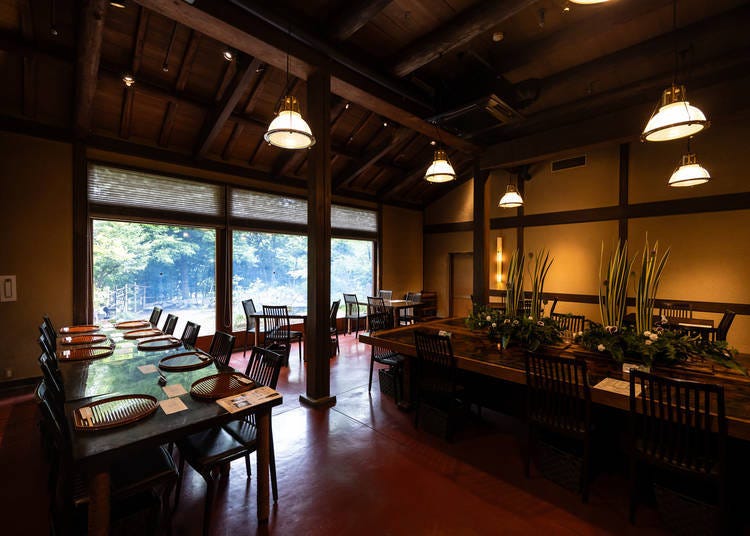
Standard Brewery Tour with Kaiseki Cuisine:
- Hours:
Mondays, Tuesdays, Fridays: 10 AM / 4:30 PM (approx. 4 hrs) - Price: 30,000 yen
-
Languages: Japanese, English
*Reservations required at least 14 days in advance
Luxury Brewery Tour with Kobe Beef Kaiseki:
- Hours:
Mondays, Tuesdays, Fridays: 10 AM / 4:30 PM (approx. 4 hrs) - Price: 60,000 yen
- Languages: Japanese, English
*Reservations required at least 14 days in advance
This time the tour was led by Italian staff member Cinzia Mesolella.
Into the Brewing Scene, Where Tradition Meets Innovation
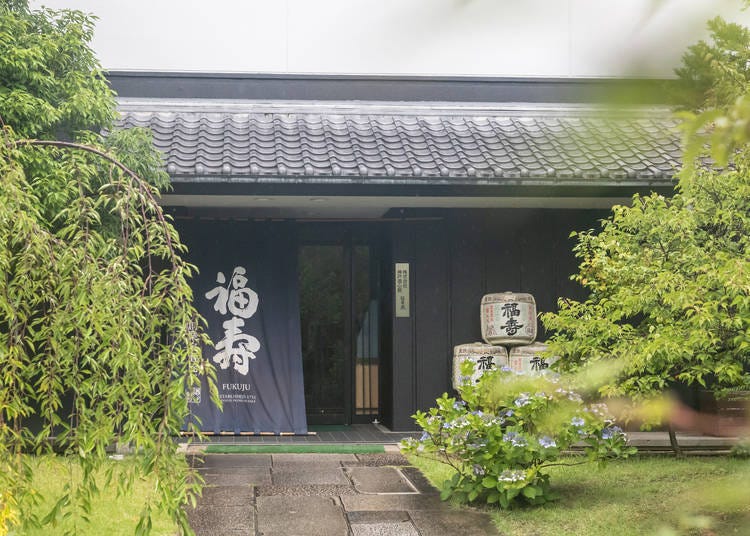
After checking in at Tomyo-gura, we head to Fukuju-gura.
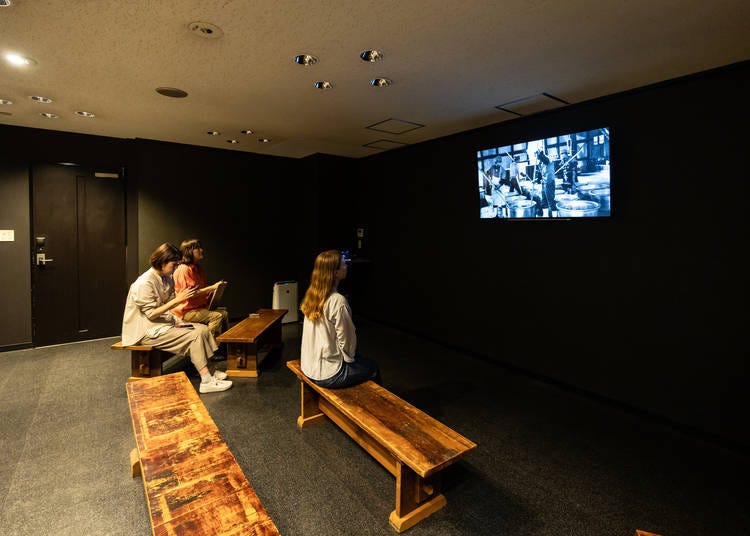
We begin on the first floor with a video introducing the history of Kobe Shushinkan and its sake brewing process. The name Fukuju comes from the deity Fukurokuju, a symbol of good fortune, wealth, and longevity. Founded 270 years ago, it’s now in its 13th generation of ownership, where the traditional sake brewing continues.
Johanna explains: “The head of the brewery bears the name Yasufuku Takenosuke through each generation. You don’t really see traditions like that abroad. The introduction to the brewery’s history and how the brewing methods changed over time also made it easier follow the rest of the tour.”

Cinzia surprised us with their extensive knowledge about the brewing process, explaining:
“Sake is made with rice, water, and koji (malted rice). It’s simple, but that’s exactly why quality is so important. Our rice comes from contract farmers in northern Kobe City, and the water is spring water from the Rokko Mountains known as Miyamizu. It’s rich in minerals and has very little iron, so it’s perfect for brewing.”
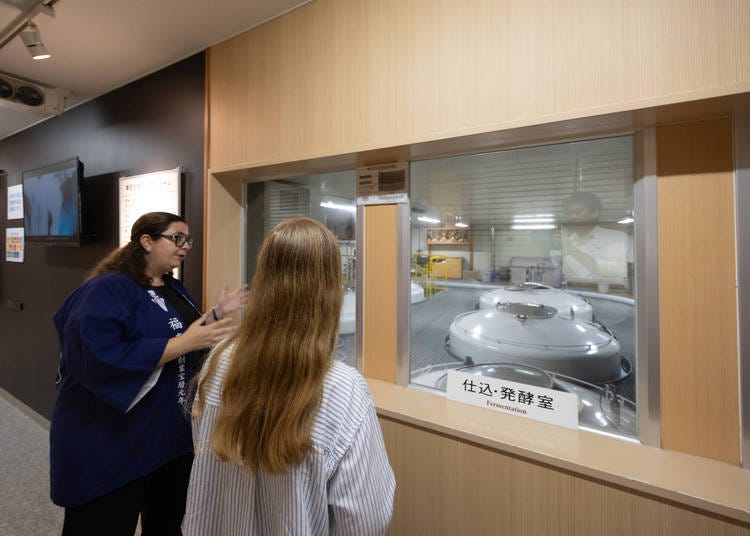
The elevator to the fourth floor gives you a view the brewery through the glass. Every stage of the brewing process is depicted through videos and panels, and supplemented by answers to all our questions, thoughtfully provided by our guide, Cinzia.
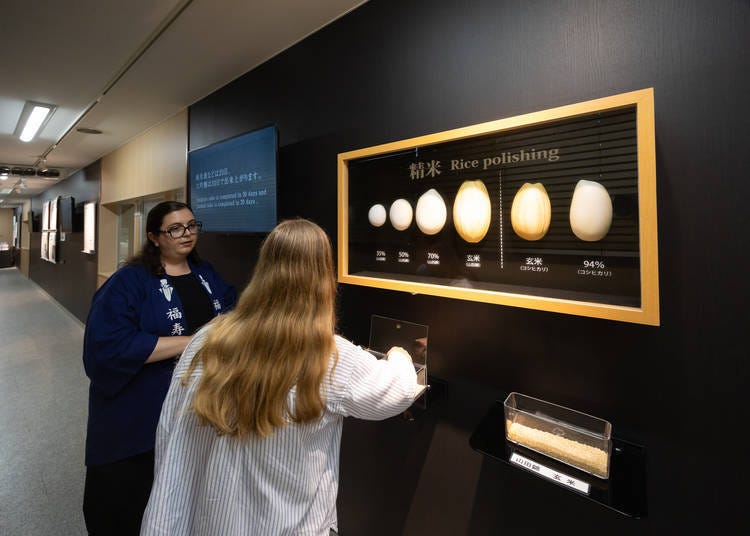
We learned about the size ratio between Koshihikari rice (for eating), and Yamada Nishiki (used for sake), as well as the degree of polishing. We even got to touch both brown rice and Yamada Nishiki rice polished to 50%.
Johanna says, “Getting to actually see and handle the rice they use in brewing was an interesting experience. When I’m drinking at a restaurant, I never really stop to think about how it’s made or where it starts, so this was a great chance to see that starting point firsthand.”
Fukuju’s Goal: Sustainable Brewing for the Future

Kobe Shushinkan’s mission is to create delicious sake with no environmental impact, launching the world’s first carbon-zero sake, Fukuju Junmai Eco Zero, in October 2022. The brewing runs on 100% renewable electricity, with heat supplied by carbon-neutral city gas. Since that launch, every bottle of Fukuju has been brewed with a carbon-zero approach.
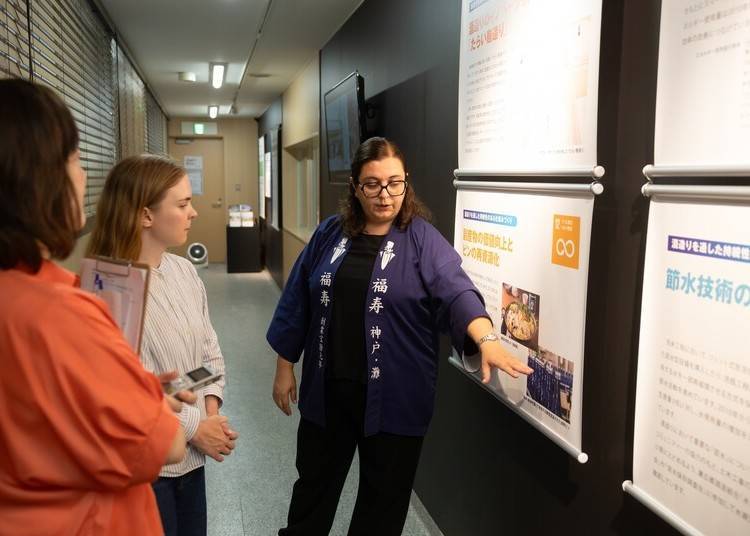
When cultivating the brewing rice Yamada Nishiki, Kobe Shushinkan uses fertilizers made from recycled resources. These include an organic digestate from a biomass plant at Yuge Farm in northern Kobe, and Kobe Harvest, a fertilizer made with recycled phosphorus from a sewage treatment plant in Higashinada Ward.
They also repurpose by-products like sake lees, turning them into sweets and serving them with dishes at their restaurant. On top of that, selling sake by weight helps cut down on waste and raises environmental awareness.
Johanna says: “What impressed me was how sake brewing isn’t just about preserving tradition, but also about the environment and local connections. It was a good reminder of how deeply rooted sake is in the local life and culture.”
Sake Tasting: Find Your Favorite Fukuju Flavor
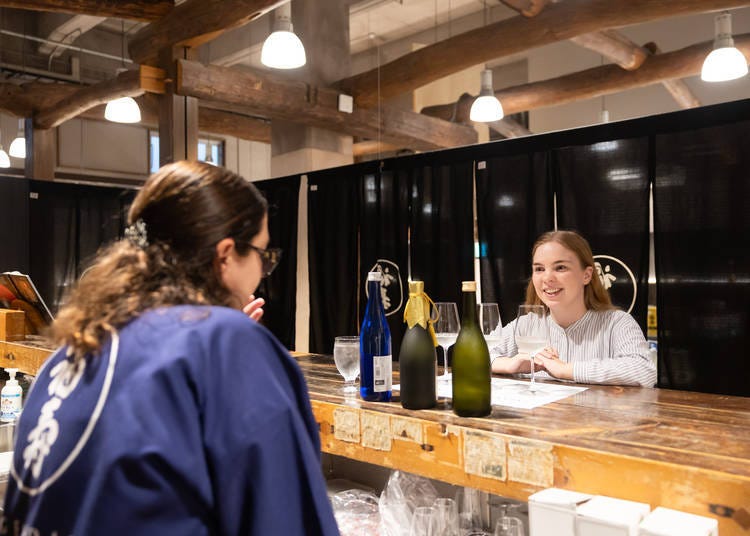
Once the tour is over, it’s time for the much anticipated bar counter. Cinzia recommends sampling all three varieties to taste and compare the flavor differences. We begin with Daiginjo Shizuku Jewelry Bottle, polished to 35% and known for its fruity and elegant aroma, followed by the more mellow-tasting Daiginjo Funashibori Shizuku, polished to 40% and pressed using traditional methods.

We finish up with Junmai Ginjo, a Fukuju classic. Polished to 60%, it brings out the natural flavor of the rice, and is even served at official Nobel Prize events.
This is also the one Johanna selects as her souvenir, explaining:
“As someone new to sake, I usually can’t tell much difference in aroma or taste, and labels or names don’t help much either. But hearing the explanations of each type of sake made it much easier. After a few tastings, I started to notice the differences little by little. I especially liked the depth of flavor of the Junmai Ginjo.”
One of the interesting things about sake is how the flavor changes depending on the polishing ratio and pressing method. The types available for tasting vary by season, so you can enjoy flavors unique to that time of year when you visit, along with limited-edition brews not available anywhere else.
Pairing Sake and Cuisine, Brewery Style
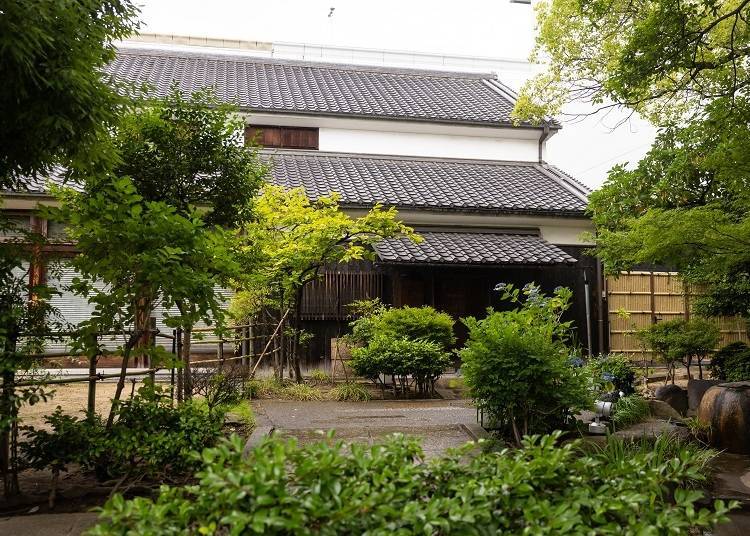
Sakabayashi, the Japanese restaurant inside Kobe Shushinkan, is a lovely space renovated from the old brewery. The menu offers kaiseki course meals along with a variety of à la carte dishes. Guests can select their favorite sake from the tasting, or ask the staff for their suggestions. Either way, it’s the perfect place to savor the delicious pairings of sake and cuisine.
Assorted Sashimi with Irizake and In-House Soy Sauce + Fukuju Junmai Daiginjo Black Label
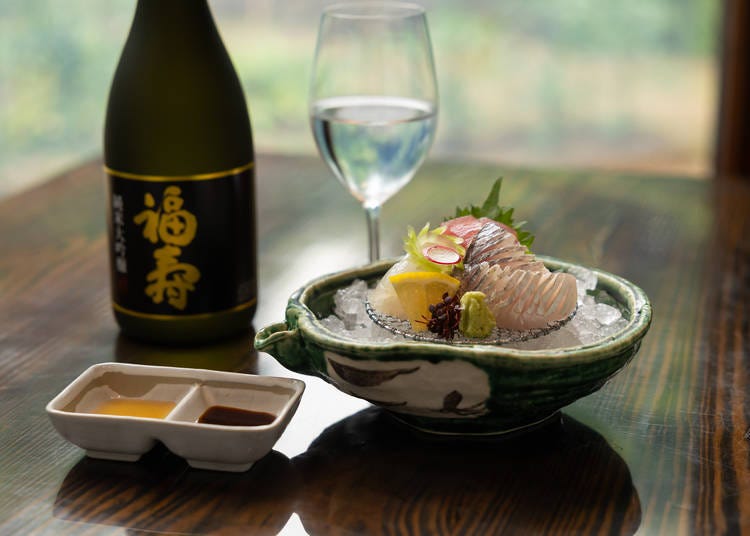
Here we’ll introduce some à la carte dishes. This is the sashimi platter, featuring three seasonal selections: splinter fish, sea bream, and tuna. Junmai Daiginjo Black Label is made from Yamada Nishiki polished to 40%, with a ginjo aroma reminiscent of white peach and pear, and a delicate flavor that perfectly complements the sashimi. This premium sake has even won the Platinum Award (one rank above Gold) at Kura Master, a competition judged by France’s top sommeliers.
Kuroge Wagyu Harihari Hot Pot + Fukuju NEXT Junmai Barrel Aged Blend

The Harihari Nabe is a hot pot dish featuring deliciously rich Kuroge Wagyu with a special dashi, balanced by the crisp texture of fresh mizuna greens. The Fukuju NEXT Junmai Barrel Aged Blend is made by combining junmai sake with sake aged in both French and American oak barrels, resulting in a rich, dry flavor profile with elegant vanilla notes and a whiskey-like character that pairs perfectly with hot pot dishes.
For those wishing to try Kobe beef, the Kobe Beef Shabusuki Mini Nabe Kaiseki is also recommended (nine dishes, 14,000 yen).
*Lunch reservations required
*Menu items vary by season
Take Home a Memory! Kobe Shushinkan’s Souvenir Selection
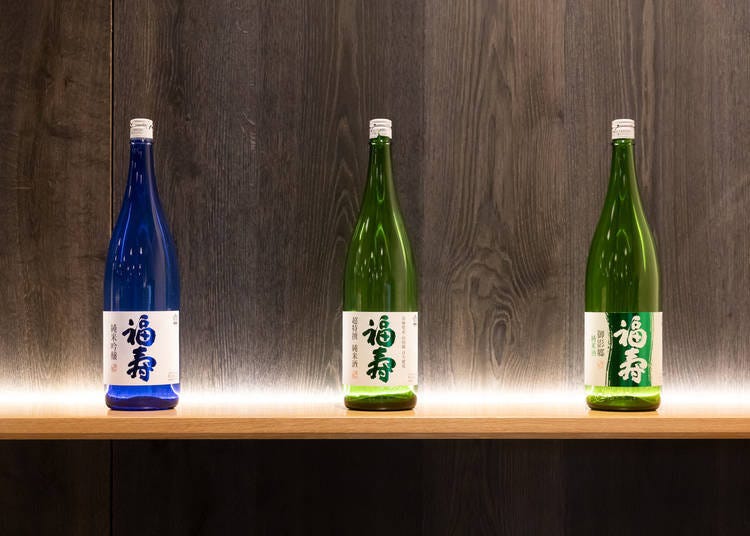
All three signature Fukuju varieties (Junmai Ginjo, Junmai Chotokusen, and Junmai Mikagego) make excellent souvenirs. There are also seasonal limited editions, only available at the brewery, so be sure to ask the staff for their recommendations.

The most popular souvenir is the brewery-exclusive Narazuke pickles (gourd or eggplant, 906 yen each). These are made by pickling salt-cured vegetables like gourd and eggplant in sake lees, giving them a distinct sweet aroma and the flavor of sake that makes them the perfect accompaniment to rice or drinks.
Discovering the Deeper Appeal of Sake at Kobe Shushinkan
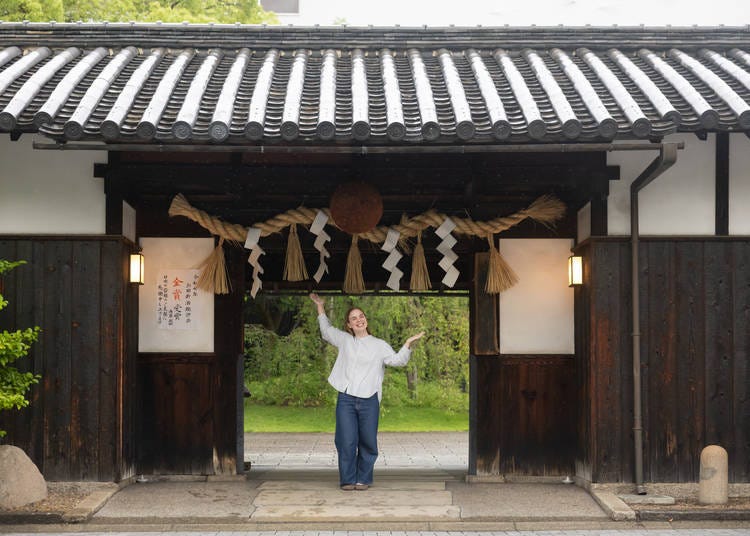
Kobe Shushinkan is a place to not only sample sake, but also learn about and experience the craft behind it. From traditional brewing to the latest popular varieties, there’s plenty to learn and discover. Johanna herself left with an even greater appreciation for sake than before!
Just remember to drink responsibly, and enjoy a visit for the delicious food and sake!
-
Kobe Shushinkan神戸酒心館
- Address 1-8-17 Mikagezuka-cho, Higashinada-ku, Kobe, Hyogo Prefecture
-
Nearest Station
About an 11-min. walk from Hanshin Iwayagawa Station, or 4 min. by taxi from Hanshin Mikage Station
- Phone Number 078-841-1121
Hours:
Brewery Shop Tomyo-gura:
10 AM– 6:30 PM (open daily except year-end/New Year holidays)
Restaurant Sakabayashi:
Lunch: 11:30 AM – 3 PM (last order: 2:30 PM)
Dinner: 5:30 PM – 9 PM (last order: 8 PM)
Sake Lounge: 2:30 PM – 5 PM (last order: 4:30 PM)
Picking the Perfect Pass for Your Nada-Gogo Visit
For exploring Nada-Gogo, one of Japan’s top sake-producing areas, the Hanshin Railway is by far the most convenient option, with many breweries located close to the stations. It’s also a safe and easy way to get around after enjoying a few drinks.
Below are some of the best passes to consider for your personal travel needs!
For Nada-Gogo Only: Hanshin Tourist Pass
Perfect for those planning to stick around Nada-Gogo, this one-day pass offering unlimited rides on the Hanshin Railway is a great deal! Exclusively available for international visitors.
For Nada Gogo + Kyoto and Osaka: Hankyu Hanshin 1-Day Pass
Best for those who want to check out Kobe, Kyoto, and Osaka in a single day. This one-day pass offers unlimited rides on both the Hankyu and Hanshin lines, allowing travel across a wider area.
Spending A Few Days in Kansai? Try the Kansai Railway Pass
Great for exploring the entire Kansai region, including Nara and Wakayama. Valid for multiple days and includes discounts at over 200 facilities.
For Longer Trips by Shinkansen: JR West Kansai WIDE Area Pass
Perfect for venturing farther out, this pass gets you to places like Okayama, Tottori, and Kinosaki Onsen, with unlimited rides on express trains and the shinkansen.
Explore Sake Breweries with Ease: Take a Guided Tour!
If you’re unsure about exploring on your own, a guided tour is a great option.
Kiko Matsuda, Keiko Kimura, Risa Tsushi, and a team of female writers familiar with Kansai. We love eating, drinking and traveling! We share fun information based on our experiences.
- Area
- Category
*Prices and options mentioned are subject to change.
*Unless stated otherwise, all prices include tax.
Popular Tours & Activitiess
Recommended places for you
-

Kanzenkoshitsuyakinikutabehodai Gyugyu Paradise Sannomiya
Yakiniku
Kobe, Sannomiya, Kitano
-

Kambei Sannomiyahonten
Yakiniku
Kobe, Sannomiya, Kitano
-
Goods
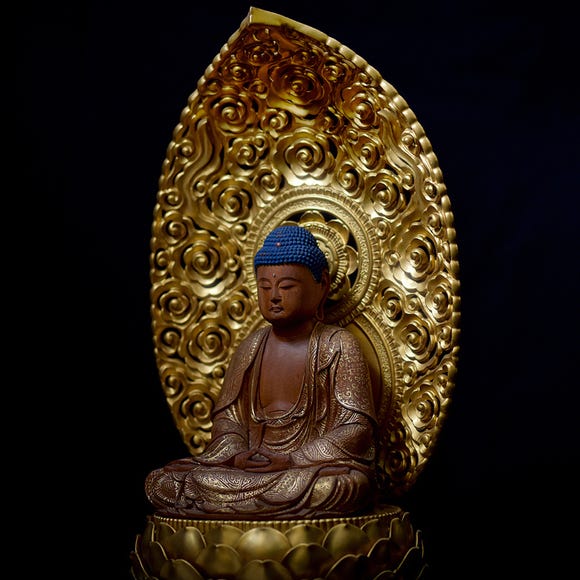
Yoshida Gennojo-Roho Kyoto Buddhist Altars
Gift Shops
Nijo Castle, Kyoto Imperial Palace
-

Jukuseiniku-to Namamottsuarera Nikubaru Italian Nikutaria Sannomiya
Izakaya
Kobe, Sannomiya, Kitano
-

ISHIDAYA Hanare
Yakiniku
Kobe, Sannomiya, Kitano
-
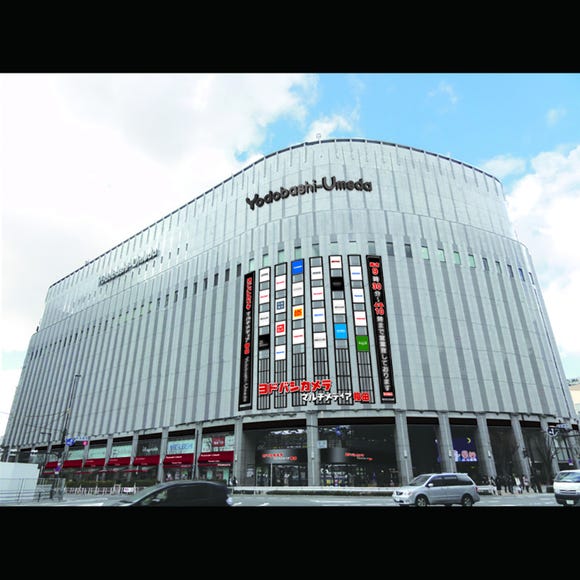
Yodobashi Camera Multimedia Umeda Store
Shopping Malls
Umeda, Osaka Station, Kitashinchi
-

New Way to Reach Koyasan! Ride Nankai's 'GRAN Tenku' for a Heavenly Journey
by: Guest Contributor
-

November Events in Kansai: Fun Festivals, Food, and Things to Do in Kyoto & Osaka
-
Ad

Experiencing Manga as Culture, Not Just Reading It: Expo 2025 with Rumiko Takahashi
-
Ad

Recharge and Relax with a Healing Getaway at Kamenoi Hotel Toba
-
Ad
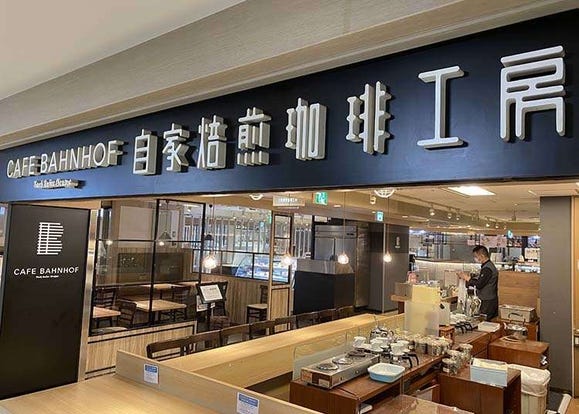
Café Bahnhof in Osaka: The home-roasted coffee that captivated G20 leaders!
-

Celebrate a Dreamy Barbapapa Christmas at JR Osaka Station's Twilight
by: Guest Contributor
Inspiration for Accommodations
-

Spacious Family Hotel in Namba: 20 Comfortable Stays for Family Fun
-
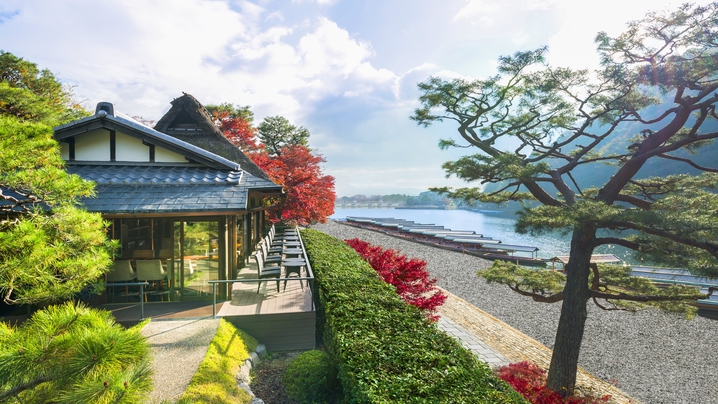
Charming Hotels to Enjoy the Spectacular Views of Arashiyama's Autumn Leaves from Your Room
-

Experience Stunning Views of Osaka Castle from Private Spaces: Top Hotels Near Osaka Castle
-
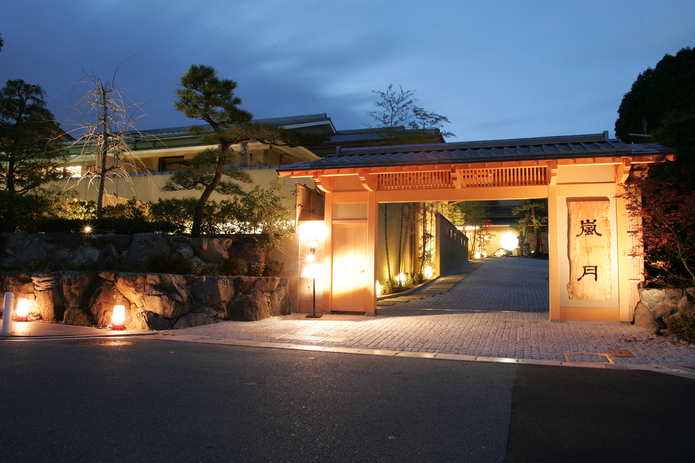
Recommended by Visitors! Arashiyama's Best-Rated Hotels
-

Family-Friendly Universal Studios Japan Hotel with Excellent Access
-
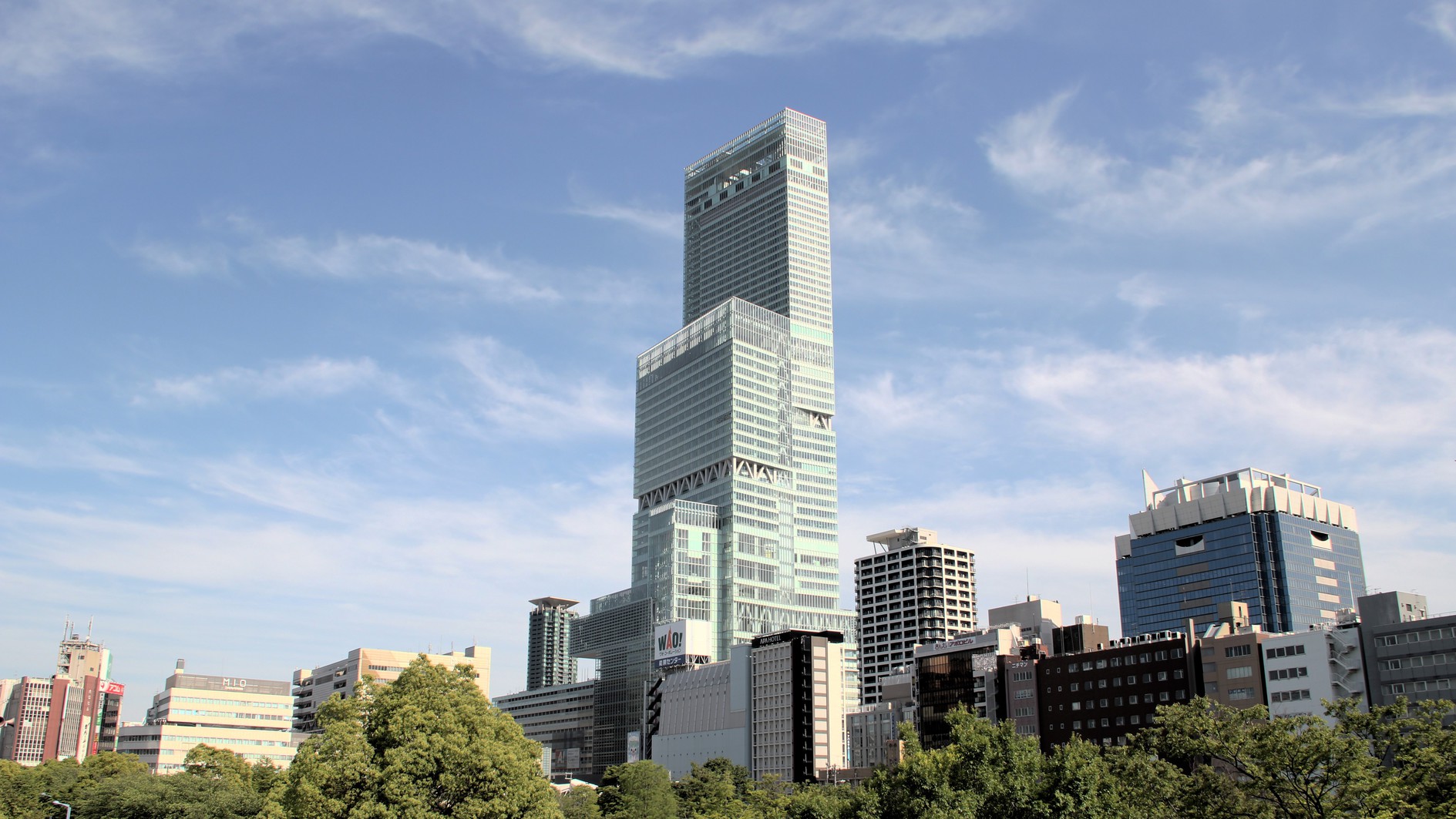
Enjoy a Comfortable Stay in Osaka! 10 Hotels with Convenient Airport Shuttle Services
-

Top 10 Recommended Hotels Near Namba Station with Great Access
-
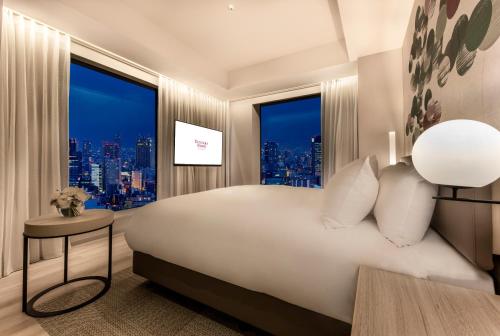
Enjoy Night Views from Your Room! Recommended Hotels in Namba Area
-
Ad

Discover Timeless Beauty: Kimono-en, a Web Magazine Exploring the Spirit of Kimono
-

Kichijoji – Explore Tokyo’s Top-Rated Stylish Suburb in Half a Day!
-

Picking the Perfect Plan: 3 Ways to Explore Sake in Nada-Gogo, Kobe
by: WESTPLAN
-

5 Must-Visit Nara Temples and Shrines: Discover the Timeless Beauty of Japan's Ancient Capital
by: WESTPLAN
-

11 Selected Kimono Rental Shops in Kyoto: Take a Stroll in Traditional Japanese Clothing
-

Healthcare in Japan for Tourists: What to Do When You Get Sick or Injured in Japan
- #best gourmet Osaka
- #things to do Osaka
- #what to do in kyoto
- #what to bring to japan
- #best gourmet Kyoto
- #new years in Osaka
- #what to buy in nanba
- #Visiting Osaka
- #onsen tattoo friendly arima
- #daiso
- #Visiting Kyoto
- #best japanese soft drinks
- #japanese fashion culture
- #japanese convenience store snacks
- #japanese nail trends














